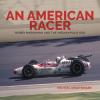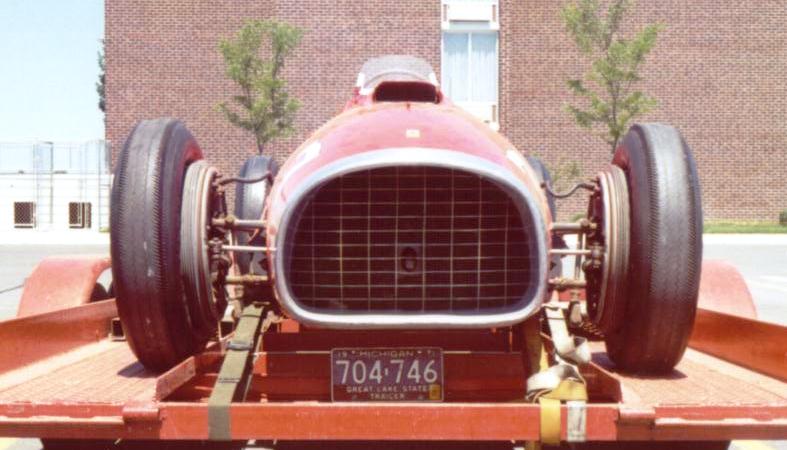1950-52 Tipo 375 F1s.
Help! I have been researching these 4.5 litre F1 Ferraris and what happened to them after their initial racing years. I am now fairly certain that Chassis number 1 became the last Thinwall Special, chassis and engine number 010. It stops being raced by the Scuderia aa #1 and then starts up as #010.
What really concerns me is 1950 chassis number 2. This is the car that was apparently driven by Juan Froilan Gonzales, to win the British Grand Prix in 1951. William Boddy, the then Editor of "Motor Sport" recorded it as "chassis Number 2." It was driven by Francisco "Chico" Landi at the 1951 Italian Grand Prix. By all the accounts that I read, he then bought it and sent it back to South America, where it languished for many years until being bought by Colin Crabbe in the mid-1970s and sent back to England. He sold the parts to Dries van der Loff of the Netherlands, who said that the car bore chassis number 5 (!). From what I read, the car has been restored as 125-C-04, which was PROBABLY driven by Ascari, on 30/7/1950 at the Swiss GP, with a Tipo 340 engine installed.
Then we have chassis number 5. Today, this belongs to Bernie Ecclestone and also claims to be the British GP winner. It was restored by Ferrari Classische in 2019-2021. (See excerpts from my database below). Can anyone please help me with discovering the real histories here? I suspect the identities may have become mixed up whilst in South America.
Finally, it is recorded that Gonzales British GP winning car had a single plug per cylinder car at that race, whilst the other team cars of Ascari and Villoresi had twin plug per cylinder engines. Why was this? Could it have been that Gonzales' car, being a 1950 build, had always kept the same type of engine, whereas the cars built in 1951 had the later, more powerful engine?
Tipo: 375 GP.
Chassis number: GP/50(2).
Factory team.
The second Ferrari 375 F1 to be introduced at the 1950 Italian GP and this one was stamped as 'GP/50/2'. Almost certainly, Ascari's car at Monza and then used by him for the first two races of 1951. After this, it became the team's "T" (practice), car and it may have been driven by Froilan Gonzales to win the British GP. After this, the same car was driven by Ascari to claim victory at the German Grand Prix on the Nürburgring. It was last seen in 1951 when it was raced by Chico Landi at the Italian GP.
1950:
1950-09-03: Italian GP, Monza F1, GP50/2 Ferrari 375F1, #16 Alberto Ascari, engine, DNF.
1950-10-29: GP de Penya Rhin, Pedralbes F1, GP/50/2, Ferrari 375F1, #2 Alberto Ascari, 1st.
1951:
1951-03-11: GP de Syracusa: A. Ascari, SF#12; DNF. Ferrari 375/50/2. Transmission, DNF. Tanner: Overheating when leading 1950 4.5 model.
1951-03-26: GP de Pau: A. Ascari, SF#12; DNF. Ferrari 375/50/2: DNF. Tanner: Transmission after leading. 1950 4.5 model.
1951-04-22: GP di San Remo: A. Ascari, "T" car/Muletto?
D. Serafini, SF#30; 2nd. Tanner: 1950 model 4.5
1951-05-27: GP of Switzerland, Bremgarten: P. Taruffi, SF#44; 2nd. Tanner: 24-plug GP/50/2.
1951-07-14: British GP, Silverstone: J-F. Gonzales, SF#12: 1st. ORC: 1st. Tanner: 12-plug. Why go back to a 12-plug engine after Swiss GP, 05/27? William Boddy, the then Editor of "Motor Sport" recorded it as "chassis Number 2."
1951-07-29: German GP, Nurburgring: A. Ascari, SF#71 1st.
ORC: 1st. Tanner: No note.
1951-08-05: Albi: F. Landi, #32; DNF. Engine.
1951-08-15: Pescara GP: DNF. ORC: Oil pressure. Tanner: Engine-1st lap. 12 plug.
1951-09-16: Italian GP, Monza: F. Landi, #12, DNF. 375/50-2. Tanner: Transmission, 12-plug 1950.
Sold to Brazilian driver Chico Landi. (375/50/2-ORC). He raced it in Uruguay in Formula libre races in 1951/2. After this, the car went back to Europe, and Landi drove it for the few races in which it could be used.
Napoleao Ribeiro records that the ex-Landi car had the customer monoposto car number 104 (This would be 1948 125 F1/F2 car 04C when sold from the factory to Landi, so the number was perhaps used on the 375 for tax purposes?)
1952:
1952-01-20: XI GP da Cidada de Rio de Janeiro: F. Landi; 2nd.
1952-03-16: Gran Premio Extraordinario de Eva Duarte Perón: F. Landi; 3rd.
1952-06-01: Gran Prix d'Albi: F. Landi, #6; 2ndOA.
1952-07-19: Silverstone: F. Landi; 3rd.
1952-08-02: Daily Mail Trophy, Boreham: F. Landi, #29; 2nd.
1952-12-14: XII GP da Cidada de Rio de Janeiro: F. Landi; DNF. (Acc.)
1953:
1953-02-01: Buenos Aires Grand Prix: A. Ascari; DNF. Engine.
(Broken con-rod).
1953-05-31: Albi GP: Heat 2: A. Ascari, #1; DNF. Gearbox.
1954:
1954-10-17: Buenos Aires Grand Prix: F. Landi, #38; DNF.
The car was then re-bodied by Scaglietti, as a central seater racer, similar to Louis Rosier's car. Ir was re-numbered as 0566. Sold to Barberis, in Brazil. The 375 was used in the 1956 Buenos Aires 1000km race, being driven by Celso Lara Barberis and Godofredo Vianna.
1956:
1956-01-29: Buenos Aires 1000 Kms: Barberis/Vianna; DNF Engine. Later, the engine was replaced with a Corvette V8 engine.
1957:
Raced by "Siri"?
1958: Now Chevrolet V8 engined.
Interlagos 500km: Fritz d'Orey; 1st.
Body further modified.
1964: Interlagos: RU.
Colin Crabbe bought it out of South/Central America in 1976.
Restored by Tony Merrick.
1977: Colin Crabbe then sold the parts to Mr. Dries van der Lof of Holland. Apparently, the chassis bears the number: #5 in the cockpit area? (Ferrari Classische-2019).
2015: Dries Van de Lof has had the car restored as 125-C-04?
375-5:
375F1-5 Ascari's 1951 Works car. -Built early 1951. This is the car that is today owned by Bernie Ecclestone (came from Albert Obrist).
1951:
1951-05-27: Swiss GP, Bremgarten: L. Villoresi, Spare, not used.
1951-06-17: Belgian GP, Spa-Francorchamps: P. Taruffi, SF#12: DNF. (Transmission).
1951-07-01: French GP, Rheims: J-F Gonzales/A. Ascari, SF#14; 2nd. Tanner: 24 plugs, re-shaped body.
1951-07-14: British GP, Silverstone: A. Ascari, SF#12. Gearbox. DNF. Tanner: Gearbox. 24 plug.
1951-07-29: German G.P.: P. Taruffi, SF#73; 5th. ORC: 5th.
1951-09-16: GP Italy: A. Ascari, #2; 1stOA. Tanner: 24-plug, re-designed high tail and headrest.
1951-10-28: Spanish GP: Pedralbes: A. Ascari, SF#2: 4th. 375-5 Ferrari. Tanner: Held up with tyre trouble.
1952?
1952-04-06: Turin GP: A, Ascari; DNF. Tanner: Split fuel tank on last few laps when leading. Indianapolis type lengthened chassis.
And then?

















